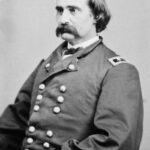John Brown’s Fort, a seemingly unassuming brick building in Harpers Ferry, West Virginia, stands as a powerful monument to a pivotal moment in American history. Originally constructed as a fire engine and guard house for the Harpers Ferry Armory, its significance was forever transformed in October 1859 when abolitionist John Brown and his men made it their stronghold during their daring raid. This article delves into the fascinating journey of John Brown’s Fort, from its humble beginnings to its place as a preserved national landmark.
Built in 1848, the structure was a functional addition to the armory. A contemporary report described it as “an engine and guard-house, 35½ x 24 feet, one story brick, covered with slate, and having copper gutters and down spouts.” Little did anyone know that this practical building would soon become the epicenter of a dramatic event that would further inflame the tensions brewing in the nation over slavery.
The building’s destiny shifted dramatically on October 16, 1859. John Brown, an ardent abolitionist, led a raid on the Harpers Ferry Armory in an attempt to incite a slave rebellion. Retreating to the engine house with his men, this building became their last stand against local militia and, eventually, U.S. Marines led by Colonel Robert E. Lee. For three days, John Brown’s Fort was the focus of national attention as the raid unfolded, culminating in Brown’s capture and subsequent trial and execution. The event deeply polarized the nation and is widely considered a significant precursor to the American Civil War.
Remarkably, John Brown’s Fort was the only armory building to survive the widespread destruction of the Civil War. However, its journey was far from over. In 1891, seeking to capitalize on its notoriety, the fort was dismantled and transported to Chicago to be displayed near the World’s Columbian Exposition. Unfortunately, it failed to attract visitors, and the dismantled structure was left abandoned on a vacant lot.
Salvation came in 1894 through the efforts of journalist Kate Field, a passionate advocate for preserving John Brown’s legacy. She spearheaded a campaign to return the fort to Harpers Ferry. Local landowner Alexander Murphy donated land, and the Baltimore & Ohio Railroad offered free transportation. By 1895, John Brown’s Fort was reconstructed on Murphy Farm, overlooking the Shenandoah River, a few miles from its original location.
In 1909, marking the 50th anniversary of John Brown’s Raid, Storer College, a historically Black college in Harpers Ferry, purchased the fort and moved it to their campus. This move further cemented the fort’s role in American memory, particularly within the context of the struggle for civil rights and racial equality.
Finally, in 1960, the National Park Service acquired John Brown’s Fort. In 1968, they moved it once more, this time closer to its original location within Harpers Ferry National Historical Park. While a railroad embankment now covers the precise original site, the fort stands approximately 150 feet east, allowing visitors to connect with this pivotal location in American history.
John Brown’s Fort stands today not just as a building, but as a powerful symbol. It represents the complexities of American history, embodying themes of abolitionism, conflict, and the long struggle for justice and equality. Its journey through time and across locations mirrors the turbulent path of American history itself, making it a must-see landmark for anyone seeking to understand the forces that shaped the nation.


